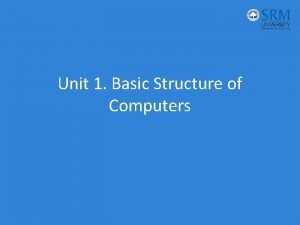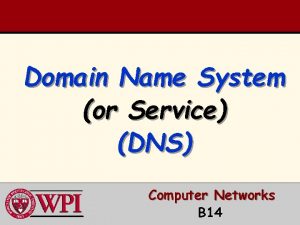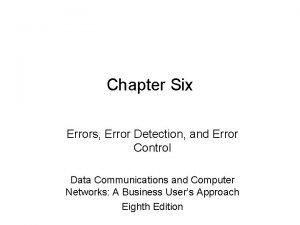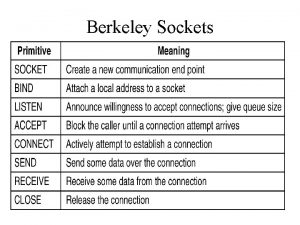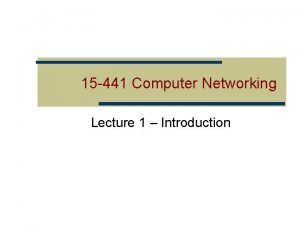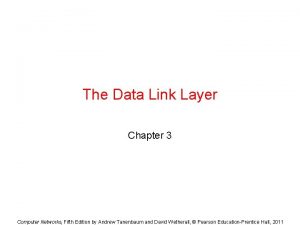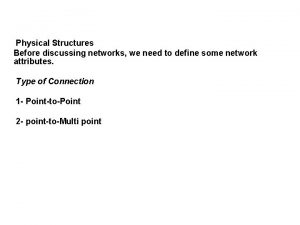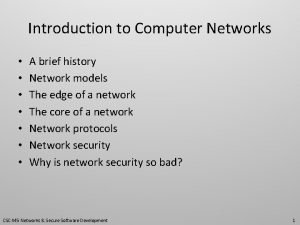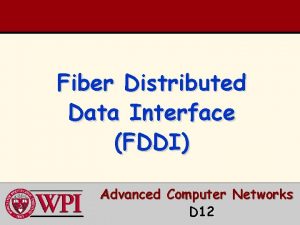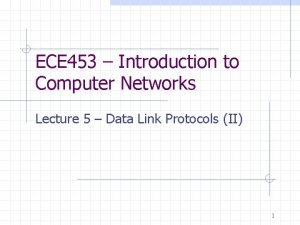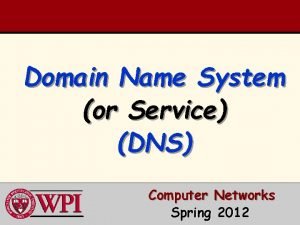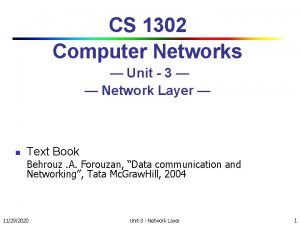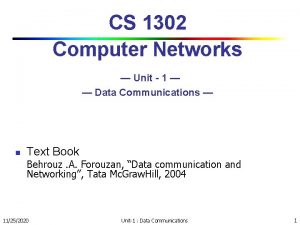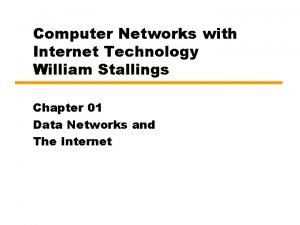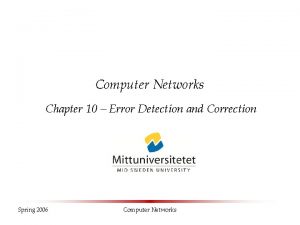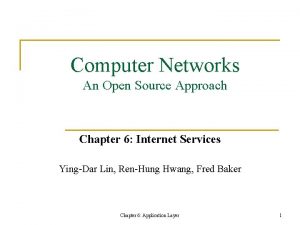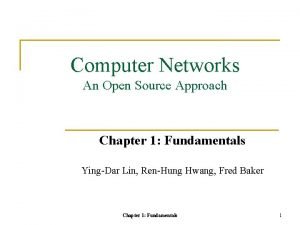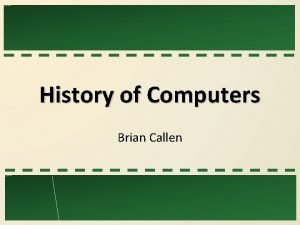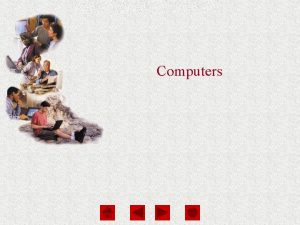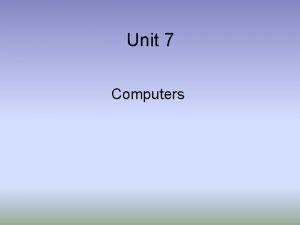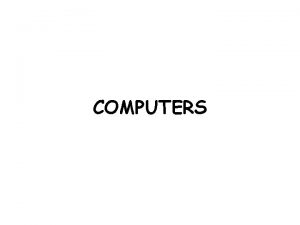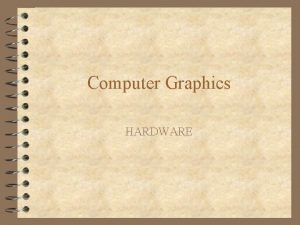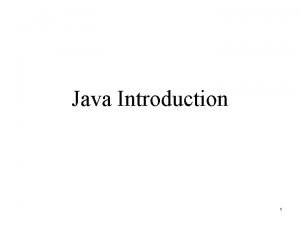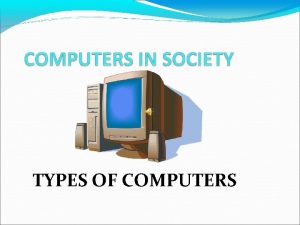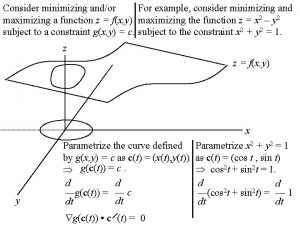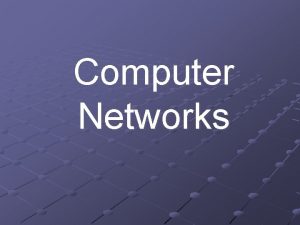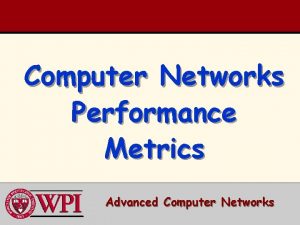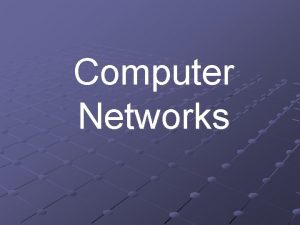Computer Networks Why Computer Networks Consider computers in




























































- Slides: 60

Computer Networks

Why Computer Networks • Consider computers in ancient times, say the 1970 s – To communicate, two computers separated by a distance had to be connected by a rented phone line to communicate – If you wanted your computer to talk to two other computers, you needed two phone lines. . . and so on.

Why Computer Networks – If you needed to communicate with 100 computers you needed 100 phone lines. – This approach did not, scale up.

Arpanet • DARPA Defense Advance Research Projects Administration. (The bad guys in the X files – Responsible for coordinating much Defense Department Research – They and the Universities they dealt with owned the lions share of the worlds computers. . . and they needed to communicate.

Arpanet • • Dedicated p Phone lines were impossible A better idea was needed Researchers had been exploring the idea of “networking” for five or six years • The better idea looked something like this. . .

The Better Idea • Given computers A, B and C – Where A is connected to B – Where B is connected to C – If C needs to talk to A • • Instead of renting another line Let C send the message for A to B Let B FORWARD the message to A In other words, use existing phone lines

The Better Idea • This was one of those simple ideas that would change the world – Appropriately, the contract was bid in 1968 and let in 1969 – The net came up in late 1969 and included • • UCLA UC Santa Barbara Stanford University of Utah

Arpanet • The net was called Arpanet and is, in fact the internet we use today • The protocol used was TCP/IP which we will study • Originally, the computers that did the message forwarding were called IMPs (Interface Message Processors) We now call machines that forward, routers.

Arpanet • Arpanet in 1977 • http: //en. wikipedia. org/wiki/Image: Arpnetmap-march-1977. png

Arpanet • Arpanet grew rapidly, by the mid eighties most colleges and Universities and private sector research facilities were on the net. • By the time of the Morris worm in the late eighties there were 10 s of thousands of machines connect to what was by then know as the internet.

Internet • In the early 90 s, AOL became the first online service to provide its customers access to the internet. • The intenet community swelled from tens of thousands of users to millions of users quite literally overnight.

World Wide Web • In 1990 CERN, a European physics center, began research on a hyperlinked document distribution system. • On August 6, 1991, a prototype of the system was launched. The collection of servers was called the World Wide Web • The first browser, Mosaic, was launched at this time.

World Wide Web • Originally, the web included mostly researchers and research centers. • Then, on day, when AOL made web browsing available to their clients, the world arrived. • You know the rest of the story

Computer Networks • In effect, the Internet makes it appear to your computer is directly connected to several million other computers. • Your computer has, as far as its concerned, a dedicated connection to that computer in an internet cafe in Kenya where that gentleman is having trouble gain access to 10 million dollars.

Computer Network Basics Computer Networks • Networks make computers much more useful by connecting them to other systems worldwide. • By connecting them to a network, we can – Look at the weather forecast

Computer Network Basics Computer Networks • Networks make computers much more useful by connecting them to other systems worldwide. • By connecting them to a network, we can – Buy a textbook

Computer Network Basics Computer Networks • Networks make computers much more useful by connecting them to other systems worldwide. • By connecting them to a network, we can – Check for a movie at a local theater

Computer Network Basics Computer Networks • Networks make computers much more useful by connecting them to other systems worldwide. • By connecting them to a network, we can – Print out an airline boarding pass

Computer Network Basics Computer Networks • Networks make computers much more useful by connecting them to other systems worldwide. • By connecting them to a network, we can – Check on your class assignments

Computer Network Basics Computer Networks • Networks make computers much more useful by connecting them to other systems worldwide. • By connecting them to a network, we can – Do a literature search for your assignment

Computer Network Basics Computer Networks • Networks make computers much more useful by connecting them to other systems worldwide. • By connecting them to a network, we can – Submit your assignment to your professor

Computer Network Basics Computer Networks • Networks make computers much more useful by connecting them to other systems worldwide. • By connecting them to a network, we can – Contact your friends to go out to celebrate finishing your assignment.

Computer Network Basics Computer Networks • Just as networks make computers much more useful by connecting them to other systems worldwide, they also make them more vulnerable.

Computer Network Basics Computer Networks • Just as networks make computers much more useful by connecting them to other systems worldwide, they also make them more vulnerable. • By connecting them to a network, we can

Computer Network Basics Computer Networks • Just as networks make computers much more useful by connecting them to other systems worldwide, they also make them more vulnerable. • By connecting them to a network, we can – Get attacked by a worm exploiting a buffer overflow weakness in your operating system.

Computer Network Basics Computer Networks • Just as networks make computers much more useful by connecting them to other systems worldwide, they also make them more vulnerable. • By connecting them to a network, we can – Receive an Trojan horse in an email and inadvertently open it, turning your computer into a zombie.

Computer Network Basics Computer Networks • Just as networks make computers much more useful by connecting them to other systems worldwide, they also make them more vulnerable. • By connecting them to a network, we can – Open a web page that infects your computer with spyware.

Computer Network Basics Computer Networks • Just as networks make computers much more useful by connecting them to other systems worldwide, they also make them more vulnerable. • By connecting them to a network, we can – Get an email with a phishing attack that fools you into giving your credit card information to an online crook.

Computer Network Basics Computer Networks • Just as networks make computers much more useful by connecting them to other systems worldwide, they also make them more vulnerable. • By connecting them to a network, we can – Give computer access to a friend, who sets up file sharing, getting you sued by the RIAA.

Computer Network Basics Computer Networks • Just as networks make computers much more useful by connecting them to other systems worldwide, they also make them more vulnerable. • By connecting them to a network, we can – You get your password for amazon. com stolen by an eavesdropper, who then buys himself a new gaming system at your expense.

Computer Network Basics Computer Networks • Network-based vulnerabilities and attacks are one of the most important security concerns.

Computer Network Basics Introduction • Traditionally, the motivation in designing computer networks was to move information quickly and reliably between computers.

Computer Network Basics Introduction • So the goal for modern computer networks was to be able to efficiently move information worldwide. • Security was initially not an issue. Speed and reliability were.

Computer Network Basics Introduction • Networks must work for many different kinds of computers. • Computers with different – Processors, – Operating systems, and – Running different network access programs.

Computer Network Basics Introduction • For that reason, networks are designed using agreed upon, standard rules, called protocols. • Any computer, operating system, and program that uses these protocols can interact with other computers over networks using the same protocols. • The protocol called TCP/IP, the Arpanet protocol, has become the defacto standard.

Computer Network Basics The Client/Server Model • Computing in computer networks is organized into a client/server model.

Computer Network Basics The Client/Server Model • As mentioned in Unit One, server computers provide services on the network. • For example, they host (provide) – – – Web sites, Email services, Calendars, Databases, Games.

Computer Network Basics The Client/Server Model • Client computers and programs access servers to take advantage of their services.

Computer Network Basics The Client/Server Model • Client computers and programs access servers to take advantage of their services. • For example, – Web browsers are clients that retrieve web pages from web servers, and then display them at the client computer.

Computer Network Basics The Client/Server Model • Client computers and programs access servers to take advantage of their services. • For example, – Email clients like Outlook, Mail, and others embedded in web browsers read and send mail by communicating with mail server computers.

TCP/IP Networks • TCP/IP is the networking protocol in the widest use. • It is the ONLY protocol used on the Internet • Networking protocols view networks as a series of layers. • Each layer is concerned with a different level of detail of transporting information across a network.

TCP/IP Layers • The TCP/IP Internet model, has the following layers: – Application Layer – Transport Layer – Network Layer – Link Layer


TCP/IP Layers • The different layers are how different parts of the computer view the task of transporting information across a network. • The layers hide detail that isn’t relevant to a particular part of the computer.


TCP/IP Packets • As we mentioned in Section Two, information in computers is in digital format, usually organized as bytes.

TCP/IP Packets • Multiple bytes of information to be sent across the network are organized into packets. – For example, a web server sending an image will send the information as one or more packets with the bytes making up the image.

TCP/IP Application Layer • The application layer is concerned with one program sending packets of data to another program on another computer across a network. • They are not concerned with the details of how this happens. – That is the concern of “lower” layers.


TCP/IP Application Layer • The application layer is controlled by programs that are part of the operating system. • When a program wants to send information, it calls the application layer program, and gives it the information to send.

TCP/IP Application Layer • The application layer is controlled by programs that are part of the operating system. • When the information arrives at the receiving computer, the application layer program delivers it to the program that is to get the information.

TCP/IP Transport Layer • The next layer down is the Transport Layer. • The transport layer handles the details of communications between a client computer and server computer.

TCP/IP Transport Layer • In particular, the transport layer – Establishes communications, – Oversees the communications between the two computers, and – Terminates communications.

TCP/IP Transport Layer • The transport layer can also track information and verify that it has been received.

TCP/IP Transport Layer • The programs that handle the transport layer on a computer are contacted by the application layer programs in the operating system, not the applications themselves. • This simplifies interactions between the application programs and the layers.



TCP/IP Transport Layer • There are two major protocols used for delivering data at the transport layer: – TCP, and – UDP.

TCP/IP Transport Layer • UDP is a simple protocol that does not promise delivery of packets.

TCP/IP Transport Layer • TCP is a more complicated protocol that does promise packet delivery.
 Andreas carlsson bye bye bye
Andreas carlsson bye bye bye Datagram approach
Datagram approach Backbone networks in computer networks
Backbone networks in computer networks Why satyam computers failed
Why satyam computers failed Dont ask
Dont ask Elements of a computer
Elements of a computer Basic structure of computer
Basic structure of computer Crc in computer networks
Crc in computer networks Crc in computer networks
Crc in computer networks Traffic management in computer networks
Traffic management in computer networks Tanenbaum
Tanenbaum What is optimality principle in computer networks
What is optimality principle in computer networks Snmp ports
Snmp ports What is optimality principle in computer networks
What is optimality principle in computer networks Business applications in computer networks
Business applications in computer networks Definition of computer
Definition of computer Intro dns
Intro dns Difference between intserv and diffserv
Difference between intserv and diffserv Icmp in computer networks
Icmp in computer networks Http computer networks
Http computer networks Framing in computer network
Framing in computer network Dns in computer networks
Dns in computer networks Computer networks assignment 1
Computer networks assignment 1 Network vs distributed system
Network vs distributed system Badrinath
Badrinath Crc example
Crc example Checksum in computer networks with example
Checksum in computer networks with example Internet transport protocol in computer networks
Internet transport protocol in computer networks Error control in computer networks
Error control in computer networks Subnet
Subnet Data link layer switching in computer networks
Data link layer switching in computer networks 2 network models
2 network models Bit stuffing refers to
Bit stuffing refers to Character stuffing example
Character stuffing example Flag byte with byte stuffing framing method
Flag byte with byte stuffing framing method Socket primitives of tcp
Socket primitives of tcp Reverse arp
Reverse arp File sender uga
File sender uga Principles of network applications in computer networks
Principles of network applications in computer networks Https://speakerdeck.com/
Https://speakerdeck.com/ 15-441
15-441 A utopian simplex protocol
A utopian simplex protocol Sonet network
Sonet network Cell switching in computer networks
Cell switching in computer networks Physical structures in computer networks
Physical structures in computer networks Explain osi reference model
Explain osi reference model Network layer design issues
Network layer design issues History of computer network
History of computer network Fddi network topology
Fddi network topology Fast ethernet in computer networks
Fast ethernet in computer networks Exponential backoff ethernet
Exponential backoff ethernet Unrestricted simplex protocol in computer networks
Unrestricted simplex protocol in computer networks Dns in computer networks
Dns in computer networks Analogue and digital transmission in computer networks
Analogue and digital transmission in computer networks Cs 1302
Cs 1302 Data communication components
Data communication components Principles of congestion control in computer networks
Principles of congestion control in computer networks William stallings computer networks
William stallings computer networks Crc in computer networks
Crc in computer networks Computer networks an open source approach
Computer networks an open source approach Computer networks an open source approach
Computer networks an open source approach






